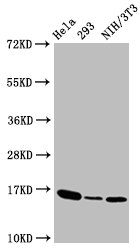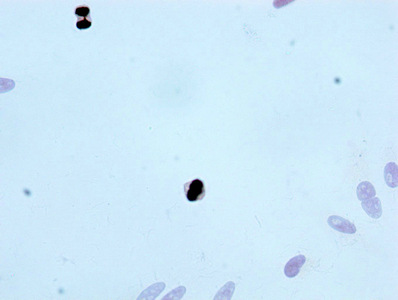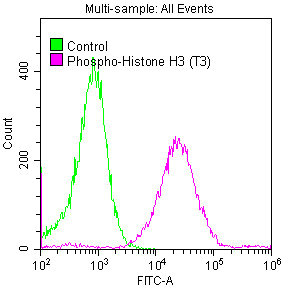
Western Blot Positive WB detected in:Hela whole cell lysate,293 whole cell lysate,NIH/3T3 whole cell lysate All lanes:Phospho-Histone H3 (T3) antibody at 1.41microg/ml Secondary Goat polyclonal to rabbit IgG at 1/50000 dilution Predicted band size: 16 KDa Observed band size: 16 KDa
Phospho-Histone H3.3 (T3) Recombinant Monoclonal Antibody

CSB-RA010109A03PHHU
ApplicationsFlow Cytometry, Western Blot, ELISA, ImmunoCytoChemistry
Product group Antibodies
ReactivityHuman
TargetH3-3A
Overview
- SupplierCusabio
- Product NamePhospho-Histone H3.3 (T3) Recombinant Monoclonal Antibody
- Delivery Days Customer20
- ApplicationsFlow Cytometry, Western Blot, ELISA, ImmunoCytoChemistry
- CertificationResearch Use Only
- ClonalityMonoclonal
- Clone ID28H4
- ConjugateUnconjugated
- Gene ID3020
- Target nameH3-3A
- Target descriptionH3.3 histone A
- Target synonymsH3 histone family member 3A; H3 histone, family 3A; H3.3A; H3-3B; H3F3; H3F3A; histone H3.3
- IsotypeIgG
- Protein IDP84243
- Protein NameHistone H3.3
- Scientific DescriptionVariant histone H3 which replaces conventional H3 in a wide range of nucleosomes in active genes. Constitutes the predominant form of histone H3 in non-dividing cells and is incorporated into chromatin independently of DNA synthesis. Deposited at sites of nucleosomal displacement throughout transcribed genes, suggesting that it represents an epigenetic imprint of transcriptionally active chromatin. Nucleosomes wrap and compact DNA into chromatin, limiting DNA accessibility to the cellular machineries which require DNA as a template. Histones thereby play a central role in transcription regulation, DNA repair, DNA replication and chromosomal stability. DNA accessibility is regulated via a complex set of post-translational modifications of histones, also called histone code, and nucleosome remodeling.
- ReactivityHuman
- Storage Instruction-20°C or -80°C
- UNSPSC12352203


